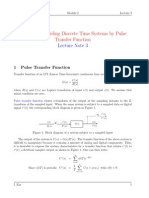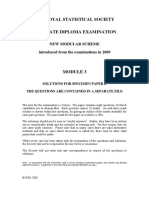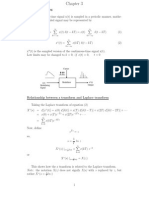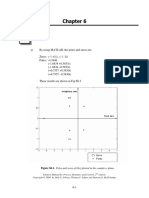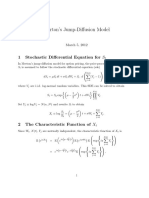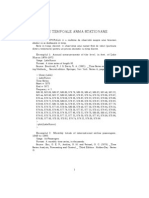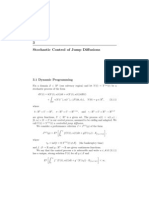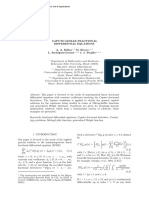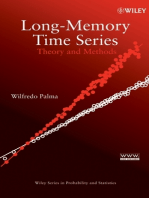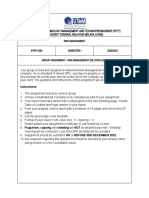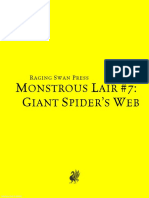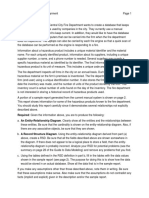Tssol 11
Tssol 11
Uploaded by
aset999Copyright:
Available Formats
Tssol 11
Tssol 11
Uploaded by
aset999Original Description:
Original Title
Copyright
Available Formats
Share this document
Did you find this document useful?
Is this content inappropriate?
Copyright:
Available Formats
Tssol 11
Tssol 11
Uploaded by
aset999Copyright:
Available Formats
Time Series 1.
(a) The lag 1 dierencing operator is dened by Xt = Xt Xt1 = (1 B )Xt and the lag d dierencing operator d by d Xt = Xt Xtd = (1 B d )Xt .
Solutions MTH 6139
Let mt = 0 + 1 t + . . . + k tk . Then, since k mt = k !k , the dierenced series k Xt will have no trend. Similarly, since d st = st std = 0, the dierenced series d Xt will have no seasonality. By combining these two operations, both the trend and seasonality can be removed from the time series {Xt }. [6] (b) When k = 1, we may write d Xt = d mt + d st + d Yt = 0 + 1 t 0 1 (t d) + d Yt = 1 d + d Yt . For stationarity, we need to check that the expectation and variance are constant, and that the covariances do not depend on t. Clearly, E (d Xt ) = 1 d, which does not depend on t. We also have cov(d Xt , d Xt+ ) = cov(d Yt , d Yt+ ) = 2Y ( ) Y ( d) Y ( + d). Since this does not depend on t, the dierenced series is stationary. [5] (c) The rst step of the classical decomposition method involves estimating the trend using a moving average lter of period length d. The seasonal eects are estimated in the next step by computing the averages of the detrended values and adjusting them so that the seasonal eects meet the model assumptions. Using the estimated seasonal eects, the time series {Xt } is then deseasonalised and the trend re-estimated using the deseasonalised variables. In the nal step, the residuals are calculated as the detrended and deseasonalised variables. [6]
Time Series
Solutions MTH 6139
2. (a) First note that E (Zt ) = 0 for all t, and so E (Xt ) = 0 for all t. Thus, we may write cov(Xt , Xt+ ) = E {(Zt + 1 Zt1 + 2 Zt2 )(Zt+ + 1 Zt+ 1 + 2 Zt+ 2 )} = E (Zt Zt+ + 1 Zt Zt+ 1 + 2 Zt Zt+ 2 + 1 Zt1 Zt+ 2 +1 Zt1 Zt+ 1 + 1 2 Zt1 Zt+ 2 + 2 Zt2 Zt+ 2 +1 2 Zt2 Zt+ 1 + 2 Zt2 Zt+ 2 ). Since the Zt are uncorrelated random variables with var(Zt ) = 2 , we obtain
2 2 (1 + 1 + 2 ) 2 2 1 (1 + 2 ) ( ) = 2 2 0
if if if if
= 0, = 1, = 2, | | > 2.
It follows that ( ) =
1 2 ) 1 (1+ 2 2
2 2 + 2 1+1 2 1+1 +2
if if if if
= 0, = 1, = 2, | | > 2.
For an MA(q ) process, ( ) is not necessarily zero when | | q and ( ) = 0 when | | > q . [12] (b) The above MA(2) process is invertible if and only if (z ) = 1 + 1 z + 2 z 2 = 0 only for |z | > 1. Solving this quadratic equation yields z= 1
2 1 42 . 22
The process is invertible for those values of 1 and 2 which satisfy |z | > 1. (c) The seasonal MA(2)h process is dened as Xt = Zt + 1 Zth + 2 Zt2h . It is invertible if and only if (z h ) = 1 + 1 z h + 2 z 2h = 0 only for |z | > 1.
[6]
[4]
Time Series 3. (a) In the operator form, the process is (B )Xt = (B )Zt ,
Solutions MTH 6139
where (z ) = 1 1 z 2 z 2 and (z ) = 1 + z . It would be an ARMA(2, 1) process if the polynomials (z ) and (z ) have no common factors. The condition for this is that 1 + 1 / 2 /2 = 0. [4] (b) The linear process form of the time series is
Xt =
j =0
j Ztj = (B )Zt ,
where (B ) =
j B j .
j =0
Thus, in terms of polynomials in z , we may write (1 1 z 2 z 2 )(0 + 1 z + 2 z 2 + . . .) = 1 + z. Equating the coecients of z j , j = 0, 1, . . ., we obtain 0 = 1, 1 = 1 + and j = 1 j 1 + 2 j 2 for j 2. When 1 = 0.3, 2 = 0.4 and = 0.9, the roots of (z ) are z1 = 2 and z2 = 5/4. So the general solution to this second-order dierence equation is
j j , + c2 z2 j = c1 z1
where c1 and c2 can be obtained from the initial conditions. In this case, the initial conditions yield the equations c1 + c2 = 1 1 4 c1 + c2 = 1.2. 2 5 These give c1 = 4/13 and c2 = 17/13. Thus, we have 17 5 4 j = (2)j + 13 13 4
j
and
for j 2. [15] (c) The dierence equations in terms of the autocorrelation function for an ARMA(2, 1) process are given by ( ) 1 ( 1) 2 ( 2) = 0 for 2 with initial conditions ( ) 1 ( 1) 2 ( 2) = 2 ( 0 + +1 1 ) (0)
for 0 < 2, where 0 = 1, 1 = and = 0 if > 1. The autocorrelation function tails o for this process. [5] 3
Time Series
Solutions MTH 6139
4. (a) There are three cases to consider: (i) || < 1; (ii) || = 1; and (iii) || > 1. In cases (i) and (iii), an AR(1) process is stationary, since Xt can be expressed as a linear combination of the Zt . It is only causal in case (i), because Xt depends on future values of Zt in case (iii). In case (ii), an AR(1) process reduces to a random walk, which is neither stationary nor causal. However, the rst dierence of a random walk is stationary, since it is just white noise. [6] (b) The dierence equation in terms of the autocorrelation function for a causal AR(1) process is ( ) ( 1) = 0 for 1 with initial condition (0) = 1. Thus, we can write ( ) = ( 1) = 2 ( 2) = . . . = (0) = for = 0, 1, . . .. Since ( ) = ( ) for all , the autocorrelation function is ( ) = | | for = 0, 1, 2, . . .. The partial autocorrelation function is 11 = and = 0 for > 1. [8] (c) The best linear predictor of Xn+1 based on X1 , . . . , Xn is Xn+1 = Xn . The Yule-Walker estimators are = (1) and 2 = (0) 1 2 (1) , where (1) is the sample autocorrelation at lag 1 and (0) is the sample variance. So the estimated predictor is (n) n X (1)Xn +1 = and
(n) n X +1 1.96 (n)
is an approximate 95% prediction interval.
[6]
Time Series
Solutions MTH 6139
5. (a) The sample ACF of yt = xt cuts o after lag 1 and the sample PACF tails o with the same sign. This suggests that yt can be modelled as an MA(1) process with a negative value of the moving average parameter. Hence, we have p = 0, q = 1, and, since the xt were dierenced once, d = 1. This means that the time series belongs to the ARIMA(0, 1, 1) class. [8] (b) The suggested model for Xt is Xt = Zt + Zt1 , which can be written as (1 B )Xt = (1 + B )Zt , where {Zt } W N (0, 2 ) and < 0. [3] (c) The residuals ACF, PACF, normal plot and histogram can be used to assess whether the residuals behave like a Gaussian white noise process. If this is the case, the sample autocorrelations at lag = 0 will be approximately zero and lie within the approximate 95% condence bounds, the normal plot will show a straight line and the histogram will be approximately bell-shaped. The Ljung-Box-Pierce Q statistic can also be used to test whether groups of autocorrelations are zero. If the null hypothesis is rejected, then there are some correlations in the data that are unaccounted for. [6]
You might also like
- TimeSeriesAnalysis&ItsApplications2e Shumway PDFDocument82 pagesTimeSeriesAnalysis&ItsApplications2e Shumway PDFClaudio Ramón Rodriguez Mondragón91% (11)
- Maurice Bessy A Pictorial History of Magic and The Supernatural 1963 PDFDocument320 pagesMaurice Bessy A Pictorial History of Magic and The Supernatural 1963 PDFaset999100% (3)
- ENEE 660 HW Sol #3Document13 pagesENEE 660 HW Sol #3PeacefulLion100% (1)
- Solutions Fourier TransformsDocument16 pagesSolutions Fourier TransformsEduardo WatanabeNo ratings yet
- Linear Algebra Cheat SheetDocument2 pagesLinear Algebra Cheat SheettraponegroNo ratings yet
- 9 Types of Mnemonics For Better MemoryDocument13 pages9 Types of Mnemonics For Better Memoryaset999100% (1)
- Baelz-Electrodyn - 2 and 3 Way Control Valves For Hot Oil - BPE57Document0 pagesBaelz-Electrodyn - 2 and 3 Way Control Valves For Hot Oil - BPE57Josito HNNo ratings yet
- Univariate Time Series Models - Cropped PDFDocument54 pagesUnivariate Time Series Models - Cropped PDFadrianaNo ratings yet
- Ts Solex Sheet 5Document2 pagesTs Solex Sheet 5aset999No ratings yet
- Chapter 4XDocument96 pagesChapter 4XAndrei FirteNo ratings yet
- Introduction To Time Series Analysis. Lecture 7.: Peter BartlettDocument42 pagesIntroduction To Time Series Analysis. Lecture 7.: Peter BartlettNoga RoseNo ratings yet
- Chapter 2 - Lecture SlidesDocument74 pagesChapter 2 - Lecture SlidesJoel Tan Yi JieNo ratings yet
- ARIMA Models: X = X + Z, ∼ W N (0, σ)Document9 pagesARIMA Models: X = X + Z, ∼ W N (0, σ)treblijNo ratings yet
- Shumway and StofferDocument5 pagesShumway and StofferReem SakNo ratings yet
- Problem Set 6: n+1 N n+1 N 1 NDocument6 pagesProblem Set 6: n+1 N n+1 N 1 NanthalyaNo ratings yet
- Problem Set 7: Y 2 X Y X ∞ −∞ X dω 2πDocument4 pagesProblem Set 7: Y 2 X Y X ∞ −∞ X dω 2πanthalyaNo ratings yet
- Z TransformDocument22 pagesZ TransformcivaasNo ratings yet
- Solutions Chapter 9Document34 pagesSolutions Chapter 9reloadedmemoryNo ratings yet
- 5modelsDocument10 pages5modelsAngry BirdNo ratings yet
- Modelling Discrete Time SystemsDocument6 pagesModelling Discrete Time SystemsSandeep KumarNo ratings yet
- Stationary Time SeriesDocument21 pagesStationary Time SeriesJay AydinNo ratings yet
- Rss Grad Diploma Module3 Solutions Specimen B PDFDocument10 pagesRss Grad Diploma Module3 Solutions Specimen B PDFA PirzadaNo ratings yet
- Time Series Lecture Notes-Ch-6Document35 pagesTime Series Lecture Notes-Ch-6yonasante2121No ratings yet
- Autoregressive, MA and ARMA ProcessesDocument100 pagesAutoregressive, MA and ARMA ProcessesjuannepomusenoNo ratings yet
- Chapter 3: Some Time-Series ModelsDocument33 pagesChapter 3: Some Time-Series Modelspayal sachdevNo ratings yet
- Random Process in Analog Communication SystemsDocument91 pagesRandom Process in Analog Communication SystemsEkaveera Gouribhatla100% (1)
- Handout2 ArmaDocument58 pagesHandout2 Armashivaniverma10398No ratings yet
- Time Series Analysis 4 25Document9 pagesTime Series Analysis 4 25wcxqqkmpwh100% (1)
- Z TransformDocument22 pagesZ Transformvignanaraj100% (1)
- Log LineariIzationDocument5 pagesLog LineariIzationaaNo ratings yet
- Mit Double PedulumDocument13 pagesMit Double PedulumAntoineNo ratings yet
- Ordinary Differential Equations in A Banach SpaceDocument17 pagesOrdinary Differential Equations in A Banach SpaceChernet TugeNo ratings yet
- Covariances of ARMA ProcessesDocument9 pagesCovariances of ARMA ProcessesRyan TeehanNo ratings yet
- Lec16 BocipherousDocument8 pagesLec16 Bocipherousdenmwa2030ceNo ratings yet
- Control Por Computador: January 15, 2014Document24 pagesControl Por Computador: January 15, 2014turbodilanNo ratings yet
- Lecture 3Document5 pagesLecture 3khalil__ullahNo ratings yet
- Hevia ARMA EstimationDocument6 pagesHevia ARMA EstimationAnthanksNo ratings yet
- Retenedor de Orden CeroDocument21 pagesRetenedor de Orden CeroLuis Miguel BarrenoNo ratings yet
- Control Por Computador: November 12, 2013Document17 pagesControl Por Computador: November 12, 2013turbodilanNo ratings yet
- Univariate Time Series Modelling and ForecastingDocument72 pagesUnivariate Time Series Modelling and Forecastingjamesburden100% (2)
- Zeno Contours, Parametric Forms & IntegralsDocument11 pagesZeno Contours, Parametric Forms & IntegralsJohn GillNo ratings yet
- 1 Time Series and Stationarity: Example Class 8Document2 pages1 Time Series and Stationarity: Example Class 8Marvin LieNo ratings yet
- Chapter 2 - Lecture NotesDocument20 pagesChapter 2 - Lecture NotesJoel Tan Yi JieNo ratings yet
- State Space ModelsDocument8 pagesState Space ModelsRamanan MuthuramanNo ratings yet
- STA222Document6 pagesSTA222j.tutoredNo ratings yet
- Process Dynamics and Control Seborg 2nd Ch06 PDFDocument43 pagesProcess Dynamics and Control Seborg 2nd Ch06 PDFRon PascualNo ratings yet
- D 57 MTW 11 SolwbDocument9 pagesD 57 MTW 11 Solwbwang.dishen0118No ratings yet
- Merton Jump - Diffusion.modelDocument7 pagesMerton Jump - Diffusion.modelIoannis MilasNo ratings yet
- The Fokker-Planck EquationDocument12 pagesThe Fokker-Planck EquationslamNo ratings yet
- ACFDocument2 pagesACFwalid Ait MazouzNo ratings yet
- Serii Tempoale Arma StationareDocument35 pagesSerii Tempoale Arma StationareCristinel MaileanuNo ratings yet
- Class Test - 2016: Electrical EngineeringDocument9 pagesClass Test - 2016: Electrical EngineeringarunNo ratings yet
- 3 Stochastic Control of Jump Diffusions: 3.1 Dynamic ProgrammingDocument19 pages3 Stochastic Control of Jump Diffusions: 3.1 Dynamic ProgrammingamirnekoeiNo ratings yet
- State Space Models and The Kalman FilterDocument49 pagesState Space Models and The Kalman FilterMohammadNo ratings yet
- Chap 6Document40 pagesChap 6pranjal meshramNo ratings yet
- Assignment 1 SolutionDocument9 pagesAssignment 1 SolutiongowthamkurriNo ratings yet
- Optimal Control (Course Code: 191561620)Document4 pagesOptimal Control (Course Code: 191561620)Abdesselem BoulkrouneNo ratings yet
- 1 s2.0 S1474667015364715 MainjlbDocument6 pages1 s2.0 S1474667015364715 MainjlbVigneshRamakrishnanNo ratings yet
- Stochastic Calculus For Finance II - Some Solutions To Chapter IIIDocument9 pagesStochastic Calculus For Finance II - Some Solutions To Chapter IIIMaurizio BarbatoNo ratings yet
- Problem Set 1Document7 pagesProblem Set 1alfonso_bajarNo ratings yet
- Student Solutions Manual to Accompany Economic Dynamics in Discrete Time, second editionFrom EverandStudent Solutions Manual to Accompany Economic Dynamics in Discrete Time, second editionRating: 4.5 out of 5 stars4.5/5 (2)
- TutankhamunDocument16 pagesTutankhamunaset999No ratings yet
- Zoroastrian Is MDocument12 pagesZoroastrian Is Maset999No ratings yet
- EssenesDocument4 pagesEssenesaset999No ratings yet
- Dagon, Babylonian DeityDocument5 pagesDagon, Babylonian Deityaset999No ratings yet
- Balfour Declaration of 1917Document7 pagesBalfour Declaration of 1917aset999No ratings yet
- Dinka PeopleDocument3 pagesDinka Peopleaset999No ratings yet
- Balfour Declaration of 1926Document1 pageBalfour Declaration of 1926aset999No ratings yet
- Carbon Cycle: From Wikipedia, The Free EncyclopediaDocument4 pagesCarbon Cycle: From Wikipedia, The Free Encyclopediaaset999No ratings yet
- ConstellationDocument4 pagesConstellationaset999No ratings yet
- Amha Selassie of EthiopiaDocument3 pagesAmha Selassie of Ethiopiaaset999No ratings yet
- Ancient RomeDocument15 pagesAncient Romeaset999No ratings yet
- Tammuz: From Wikipedia, The Free EncyclopediaDocument2 pagesTammuz: From Wikipedia, The Free Encyclopediaaset999No ratings yet
- Amha Selassie of EthiopiaDocument3 pagesAmha Selassie of Ethiopiaaset999No ratings yet
- Alexander The GreatDocument15 pagesAlexander The Greataset999No ratings yet
- AllatDocument1 pageAllataset999No ratings yet
- Zoroastrian Is MDocument12 pagesZoroastrian Is Maset999No ratings yet
- Umma Party: Sudan Table of ContentsDocument1 pageUmma Party: Sudan Table of Contentsaset999No ratings yet
- The Aquarian Gospel of Jesus The ChristDocument3 pagesThe Aquarian Gospel of Jesus The Christaset999No ratings yet
- Semjasa, Billy MeierDocument4 pagesSemjasa, Billy Meieraset999100% (1)
- 4.28 Analog Output Module SM 332 AO 4 (6ES7332-5HD01-0AB0) : X 12 BitsDocument4 pages4.28 Analog Output Module SM 332 AO 4 (6ES7332-5HD01-0AB0) : X 12 BitsMarco BustosNo ratings yet
- ProIT - Ebrochure FinalDocument5 pagesProIT - Ebrochure FinalAlqamar AtchaNo ratings yet
- 3GPP TR 21.801Document5 pages3GPP TR 21.801santanameroNo ratings yet
- Introduction To Digital Image Processing: (C) 2002-2004 by Yu Hen HuDocument11 pagesIntroduction To Digital Image Processing: (C) 2002-2004 by Yu Hen HuKurnia PrastyaNo ratings yet
- #Winkler FEM FinalDocument256 pages#Winkler FEM FinaladuladorNo ratings yet
- UniBeast - Install OS X El Capitan On Any Supported Intel-Based PCDocument21 pagesUniBeast - Install OS X El Capitan On Any Supported Intel-Based PCHJ HJNo ratings yet
- vgnFE PDFDocument12 pagesvgnFE PDFSantiago Uriel Salazar HuertaNo ratings yet
- Tables of Functions Lesson PlanDocument1 pageTables of Functions Lesson PlanJonathan RobinsonNo ratings yet
- Experiment 4: Circle Drawing Using Bresenham's Circle AlgorithmDocument6 pagesExperiment 4: Circle Drawing Using Bresenham's Circle AlgorithmMohit chauhanNo ratings yet
- Action Research Sample FormatDocument2 pagesAction Research Sample FormatRobert Merginio CatapusanNo ratings yet
- Chapter 4 PSLDocument8 pagesChapter 4 PSLMark NeishaburiNo ratings yet
- Using SQL ServerDocument6 pagesUsing SQL ServerMiftah TemamNo ratings yet
- DLL - MTB MLE3 - Q4 - W2 Paggawa NG Banghay NG Ulat EdumaymaylauramosangieDocument6 pagesDLL - MTB MLE3 - Q4 - W2 Paggawa NG Banghay NG Ulat EdumaymaylauramosangieROSVIE APPLE BUENAVENTURANo ratings yet
- EC312 Object Oriented ProgrammingDocument3 pagesEC312 Object Oriented ProgrammingJazir HameedNo ratings yet
- BTMT 4293 Group Assignment Risk ManagementDocument3 pagesBTMT 4293 Group Assignment Risk ManagementXiao Wan TeohNo ratings yet
- Onstrous AIR Iant Pider S EB: M L #7: G S ' WDocument8 pagesOnstrous AIR Iant Pider S EB: M L #7: G S ' WBaisserNo ratings yet
- Ffa08 - g05 - en (Drawer & Runner Systems)Document244 pagesFfa08 - g05 - en (Drawer & Runner Systems)GetziNo ratings yet
- Capstone DoKonsulta Pagandahan Diestro Cifra 3rd RoutingDocument10 pagesCapstone DoKonsulta Pagandahan Diestro Cifra 3rd RoutingAlleyNo ratings yet
- Numerical Inversion of Laplace Transforms in MatlabDocument4 pagesNumerical Inversion of Laplace Transforms in MatlabErza ScarletNo ratings yet
- GRP26-03 - Fire Security Products PDFDocument2 pagesGRP26-03 - Fire Security Products PDFfesterrNo ratings yet
- Adobe Scan 27-Mar-2024Document12 pagesAdobe Scan 27-Mar-2024hapiness1131No ratings yet
- Lecture 03Document46 pagesLecture 03Daiki StarkNo ratings yet
- Installing Nagios XI Manually On LinuxDocument7 pagesInstalling Nagios XI Manually On Linuxoussama ouakibNo ratings yet
- 21.concurreny Controllocks DeadlockDocument42 pages21.concurreny Controllocks DeadlockAnkit RajputNo ratings yet
- VLAN Trunk and Flood For Physical Network Traffic MonitoringDocument5 pagesVLAN Trunk and Flood For Physical Network Traffic MonitoringToonkraft SchefferNo ratings yet
- M2 +Fundamental+of+Computer-Aided+Mathematical+CalculationsDocument4 pagesM2 +Fundamental+of+Computer-Aided+Mathematical+CalculationsKpop Harteu100% (1)
- Iso 11783 6 2018Document15 pagesIso 11783 6 2018robert.cesarNo ratings yet
- Vidtoon Swipe EmailsDocument23 pagesVidtoon Swipe EmailsGAMING AND TECH ZONENo ratings yet
- Problem Statement: The Central City Fire Department Wants To Create A Database That KeepsDocument2 pagesProblem Statement: The Central City Fire Department Wants To Create A Database That Keeps44 sirumbayee GNo ratings yet



















